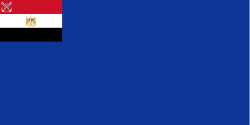| Flag | Date | Use | Description |
|---|
 | 1919 | Flag used during the anti-British Revolution of 1919 | Green flag with a white crescent and a white cross symbolizing the common struggle of Egyptian Muslims and Egyptian Christians against the British occupation. [8] Associated with the Wafd Party. |
 | 1950s | Proposed flag for the Republic of Egypt following the Egyptian Revolution of 1952 | Egypt became a republic in 1953, the year after King Farouk was toppled in the revolution, and several proposals for a new national flag were made combining elements of the old flag of the kingdom with the 1952 Egyptian Revolution Flag. This design features the entire flag of the Kingdom of Egypt in the canton of the 1952 Egyptian Revolution tricolour (i.e. the 1952 Egyptian Revolution Flag without the Eagle of Saladin). |
 | Egypt became a republic in 1953, the year after King Farouk was toppled in the revolution, and several proposals for a new national flag were made combining elements of the old flag of the kingdom with the 1952 Egyptian Revolution Flag. This design features the 1952 Egyptian Revolution tricolour in the canton of the flag of the Kingdom of Egypt, the latter modified with the white crescent and stars re-positioned to the right to accommodate the tricolour in the canton. |
 | Egypt became a republic in 1953, the year after King Farouk was toppled in the revolution, and several proposals for a new national flag were made combining elements of the old flag of the kingdom with the 1952 Egyptian Revolution Flag. This design features the flag of the Kingdom of Egypt - white crescent and stars on a green field - inverted horizontally on the left, and the 1952 Egyptian Revolution tricolour as an elongated chevron on the right. |
 | Egypt became a republic in 1953, the year after King Farouk was toppled in the revolution, and several proposals for a new national flag were made combining elements of the old flag of the kingdom with the 1952 Egyptian Revolution Flag. This design features the Arab Liberation tricolour, with the flag of the Kingdom of Egypt inverted horizontally as a chevron on the right. |
 | Egypt became a republic in 1953, the year after King Farouk was toppled in the revolution, and several proposals for a new national flag were made combining elements of the old flag of the kingdom with the 1952 Egyptian Revolution Flag. This design features the white crescent and stars on a green field of the flag of the Kingdom of Egypt rotated 90° crowned by a white representation of the three Pyramids of Giza all appearing on the left, and the Arab Liberation tricolour on the right. |
 | Egypt became a republic in 1953, the year after King Farouk was toppled in the revolution, and several proposals for a new national flag were made combining elements of the old flag of the kingdom with the 1952 Egyptian Revolution Flag. This design features a white representation of the River Nile on the green field of the flag of the Kingdom of Egypt, with the 1952 Egyptian Revolution symbolic tricolour in a right-hand side canton onto which the crescent and three stars of the flag of the Kingdom of Egypt are placed and rendered in gold. |
 | A horizontal tricolour of red, white, and black. |
































































